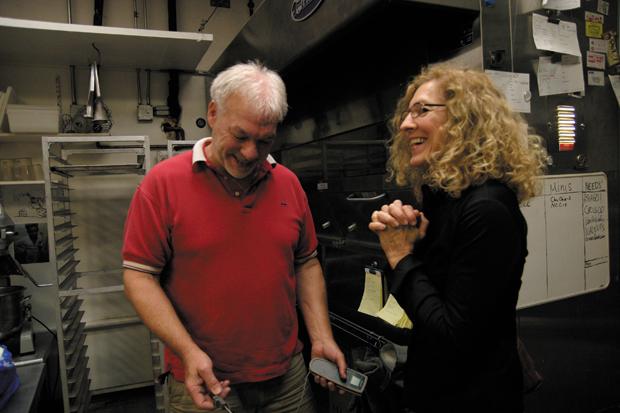Seeking cheesecake perfection
Published May 23, 2012
Shavuot commemorates the day the Jewish people received the Torah. We mark this holiday in a number of ways: studying Torah, celebrating the year’s first harvest, and enjoying a festive dairy meal. And whether your festive menu includes blintzes, bagels and cream cheese, stuffed vegetables, pasta, or kugel, it will more than likely conclude with a rich and delicious cheesecake. In Israel, bakeries go into high gear before Shavuot to meet the demand. Indeed, many Israelis refer to Shavuot as ‘The Cheesecake Holiday.”
And in St. Louis, this holiday treat has an unexpected link to the son of a pipefitter. But more on that later.
I confess that cheesecake has always seemed a generational preference — my parents’ generation, that is. It once conjured images of elderly Miami Beach Jews feasting on a cherry-topped slab at Wolfie Cohen’s Rascal House. But Wolfie Cohen’s is long gone, as is the stereotype. This is evident by the swooning reactions of many of my younger peers at the sight of cheesecake on a menu and the raptures of guests at dinner parties when the hostess brings out a homemade version of this dessert. For further evidence, check out the scores of high-end mail order bakeries, such as Eli’s in Chicago, Charlie’s Cheesecake Works in San Jose, and S&S Cheesecake in New York, which cater to this enthusiastic fan base. I realized that I was not giving this dessert its due.
ADVERTISEMENT
Never one to let a great dessert pass me by, I decided to reconsider. By perusing numerous cookbooks and online blogs, I learned that cheesecake has come a long way from the classic 1950s New York deli version, that dense wedge of cake topped by a pool of glistening cherry-pie filling. While that classic has remained popular, there are now innumerable varieties that include cheesecake bars, cheesecake pops, tiered wedding cheesecakes, cheesecake parfaits, and cheesecakes encased in dark chocolate ganache. There are even savory cheesecakes like pesto, sun-dried tomato, and salmon that can be served as an appetizer or a main course.
Where once the range of cheesecake flavors was limited to either vanilla or lemon, these days the number of flavors available would rival even Baskin Robbins 31. At Hank’s Cheesecakes, our town’s most famous purveyor of this dessert, the flavors range from Dreamsicle to Caramel Macchiato to Irish Cream to Peanut Butter Chocolate.
Nevertheless, even in this new era of cheesecakes, two things have remained the same: the mixing and the baking.
To mix the batter, you beat either cream cheese or ricotta cheese until creamy and then gradually add granulated sugar. When the cheese and sugar are combined you add eggs, one at a time, along with any additional flavoring. The preferred baking vessel is still the springform pan, which may or may not be lined with a cookie crumb or piecrust. The pan is then set into the oven, either on a rack or into a larger pan filled with boiling water (a water bath), to bake at a moderate temperature (around 325 degrees) for about an hour.
ADVERTISEMENT
Sounds easy, eh? There is one important caveat: not every cheesecake will turn out tender and free from cracks. This is where the pros come in. Harold McGee, author of the indispensable book for cooks, “On Food And Cooking,” has identified four basic strategies to avoid having your cheesecake crack, shrink, or dry out.
Beat the ingredients in a mixer on a low speed, just long enough for them to be thoroughly combined. Beating too long will create air in the batter. When the cake bakes, those air pockets fill with steam. When the cake cools, the air pockets will deflate, causing your cake to crack and shrink.
Bake cheesecakes for a longer time at a lower temperature (about 325 degrees) than other cakes.
A cheesecake is completely baked when the center still jiggles. It will continue to cook out of the oven and will solidify once it has been refrigerated for a minimum of four hours.
Once the cheesecake has finished baking, turn the oven off, put the oven door ajar, and leave the cake to cool to room temperature in the oven.
Which brings me to that pipefitter’s son, Hank Krussel. He is the Hank of Hank’s Cheesecakes on Big Bend in Richmond Heights. If anyone knows cheesecake, Hank does. His 34 flavors, plus a handful each of sugar-free and savory cheesecakes, are recognized for their consistent high quality and great taste. The bakery will celebrate its 25th anniversary this fall.
Hank’s love of cheesecake dates back to his childhood. His father was a pipefitter, and one of his loyal customers was the Raskas family’s dairy. When the dairy had pipe problems, they called on Hank’s father, and invariably the family sent him home with a big bag of cream cheese for his own family. Hank’s mother, faced with an abundance of Raskas Cream Cheese, began making the unbaked version known as Refrigerator Cheesecakes.
Hank’s childhood love of cheesecakes was ratcheted up a notch during his years in the army, where a female lieutenant used to bring in a variety of cheesecakes she baked. Following his military service, Hank began baking cheesecakes in his apartment, experimenting with different recipes. When invited over for dinner, he would always take one of his cheesecakes. His reputation grew, he developed a loyal fan base, and soon friends and family were urging him to open his own cheesecake bakery. Twenty years ago, Hank moved to his current location in Richmond Heights.
Hank recognizes the challenge for home bakers, and offers this advice:
“If it cracks, it doesn’t mean it’s ruined,” he explained. “You can always cover it up with a topping. However, if the cracks really bother you, keep track of your time and temperature and bake the cakes one minute less each time. Eventually you will customize the baking process for your own oven.”
And how do you know when the cake is finished baking?
“I like to keep my cakes soft and creamy in the center,” he said. “If the outer half of the cake looks done and the inner half looks not quite set, it’s a perfect time to pull it out of the oven.”
And once the cake comes out of the oven, how do you store it?
“First,” said Hank, “let the cake cool to room temperature. Then you should place the cheesecake, uncovered, in the refrigerator for a few hours. Once it is cold, remove the sides of the pan. To remove the bottom of the pan, set the cake onto a warm towel for a few minutes and slide the base of the pan out as you slide the cake onto a plate or platter.”
Hank says that cheesecakes usually stay fresh for one week in the refrigerator. For optimum flavor, he recommends they be served at room temperature. When you put the cheesecake back in the refrigerator, he suggests putting it into a roomy box or covering it lightly. Otherwise, as moisture evaporates it will rain back down on the cake, making the surface wet.
Though you cannot freeze cream cheese, you can freeze cheesecakes. Hank’s tip: simply wrap the cake in a double layer of heavy-duty foil or place it in an airtight jumbo freezer bag. It can remain frozen for a maximum of three months. It can also be refrozen without compromising the texture or flavor.
To thaw, simply place the wrapped cheesecake in the refrigerator overnight. Alternatively, it can thaw at room temperature for an hour or two, loosely wrapped.
And here are a few of my tips:
You can make an easy cheesecake crust by mixing ground cookies with melted butter and, if you desire, additional sugar, spices, or ground nuts. The cookies you can grind can include graham crackers, chocolate wafers, vanilla wafers, ginger snaps, macaroons, or amaretti. I happen to prefer the Nabisco chocolate wafers.
You can make your filling creamier by adding plain cream, crème fraîche, or, for a tangier flavor, sour cream. Here is a basic recipe to get you started.
Basic Cheesecake
Recipe adapted from Tyler Florence
Ingredients
Crust
- 2 cups finely ground graham crackers (about 30 squares)
- 1 stick unsalted butter, melted
Filling
- 2, 8-ounce packages cream cheese, at room temperature
- 3 eggs, at room temperature
- 1 cup granulated sugar
- 1 pint sour cream, at room temperature
- Finely grated zest of 1 lemon
- 1/4 tsp. vanilla extract
Directions:
For the crust: Preheat the oven to 325 degrees F.
In a mixing bowl, combine crust ingredients with a fork until evenly moistened. Lightly coat the bottom and sides of an 8-inch springform pan with non-stick cooking spray. Using an oiled piece of waxed paper, press the crumbs down onto the base and 1-inch up the sides of the pan. Refrigerate for 5 minutes.
For the filling: In the bowl of an electric mixer, beat cream cheese on medium speed for 1 minute until smooth and free of any lumps. Gradually add sugar. Reduce mixer speed and add eggs, 1 at a time, just until fully incorporated. Add sour cream, lemon zest, and vanilla and beat just until creamy, 1 to 2 minutes, stopping the machine once in between to scrape down the sides and bottom. Pour the filling into the crust-lined pan and smooth the top with a spatula.
Set the cheesecake pan on a large piece of heavy aluminum foil and fold up the sides around it, leaving the cake uncovered. Set this pan into a large roasting pan. Pour boiling water into the roasting pan until the water is about halfway up the sides of the cheesecake pan; the foil will keep the water from seeping into the cheesecake. Bake for 45 minutes. The cheesecake should still jiggle (it will firm up after chilling), so be careful not to overcook. Let cool in pan for 45 minutes. Chill in the refrigerator, uncovered, for at least 4 hours. Loosen the cheesecake from the sides of the pan by running a thin metal spatula around the inside rim. Unmold and transfer to a cake plate. Top cake with a fruit sauce or place a ladle of fruit sauce on a plate and place cake on top of sauce.
Slice cheesecake with a thin, non-serrated knife that has been dipped in hot water. Wipe dry after each cut.
Makes 6-8 servings.
















